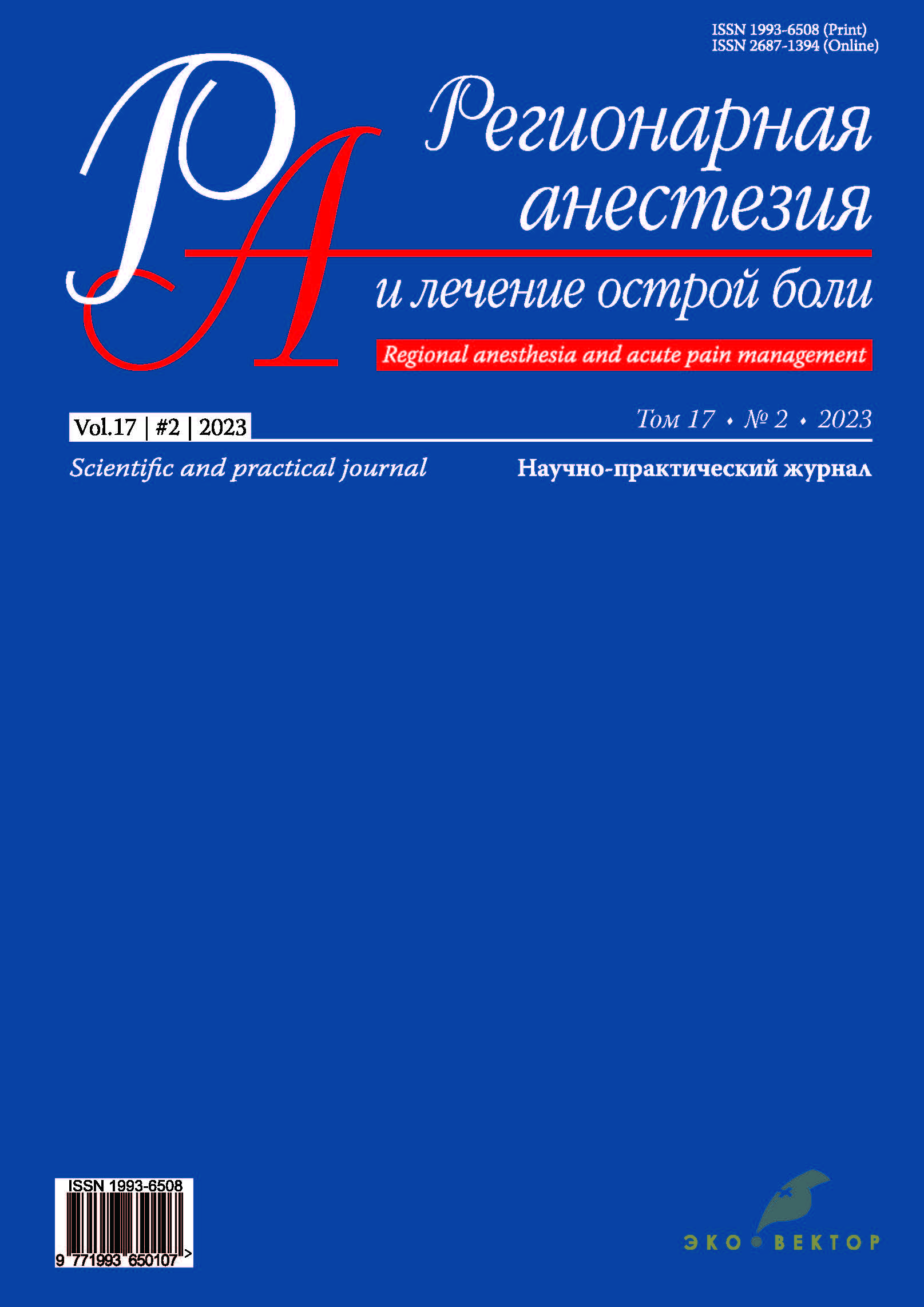Possibilities of using regional anesthesia with diode-laser transscleral cyclophotocoagulation in children: description of clinical cases
- Authors: Bersenev S.V.1, Konyaeva J.M.1, Yurchenko O.M.1
-
Affiliations:
- Ekaterinburg Center of IRTC «Eye Microsurgery»
- Issue: Vol 17, No 2 (2023)
- Pages: 125-134
- Section: Original study articles
- Submitted: 02.06.2023
- Accepted: 30.06.2023
- Published: 06.08.2023
- URL: https://rjraap.com/1993-6508/article/view/472093
- DOI: https://doi.org/10.17816/RA472093
- ID: 472093
Cite item
Abstract
BACKGROUND: Diode-laser transscleral cyclophotocoagulation (DLTCPC) is one of the most commonly used treatment options for intraocular pressure reduction in refractory glaucoma in adult and pediatric patients. To achieve the necessary effect, these operations often have to be repeated. Repeated general anesthesia inductions increase the risk of cognitive disorders in children and sometimes do not provide sufficient postoperative analgesia.
OBJECTIVE: To analyze the results of transscleral DLTCPC in children under regional anesthesia and identify factors predisposing to the choice of this anesthesia method.
MATERIALS AND METHODS: The study included 33 children aged 10–17 years who had undergone 57 transscleral DLTCPCs in IRTC Eye Microsurgery Ekaterinburg Center between 01.09.2017 to 31.08.2022. In each case, the anesthesia method was selected individually according to the principle of reasonable sufficiency.
RESULTS: Of 57 operations, 36 (73%) were performed under regional and 21 (37%) were under general anesthesia. Factors that favor regional anesthesia include (1) psycho-emotional maturity of the patient, (2) older age, and (3) greater number of previous operations. An algorithm for the selection of the anesthesia method is presented, as well as a plan for the conversation with the patient and his / her legal representatives. Regional anesthesia provides good intra- and postoperative anesthesia and prophylaxis of postoperative cognitive disorders in children who are emotionally stable and suitable for this type of anesthesia.
CONCLUSION: Considering the psycho-emotional features of children, general anesthesia remains the main method in ophthalmic anesthesiology. Nevertheless, following the principle of reasonable sufficiency and accounting for the short duration of DLTCPC and the large extent of general anesthesia survived by these children previously, regional anesthesia can be successfully used in a portion of these children.
Full Text
About the authors
Sergei V. Bersenev
Ekaterinburg Center of IRTC «Eye Microsurgery»
Author for correspondence.
Email: serg_bersenev@mail.ru
ORCID iD: 0009-0004-9246-8969
SPIN-code: 6143-7472
MD, Cand. Sci. (Med.)
Russian Federation, EkaterinburgJulia M. Konyaeva
Ekaterinburg Center of IRTC «Eye Microsurgery»
Email: Juliakis@icloud.com
ORCID iD: 0009-0005-2938-4575
SPIN-code: 9886-2000
Russian Federation, Ekaterinburg
Olga M. Yurchenko
Ekaterinburg Center of IRTC «Eye Microsurgery»
Email: Bagi6@mail.ru
ORCID iD: 0009-0001-8840-6923
SPIN-code: 8293-3819
Russian Federation, Ekaterinburg
References
- Elhefney EM, Mokbel TH, Hagras SM, et al. Micropulsed diode laser cyclophotocoagulation in recurrent pediatric glaucoma. Eur J Ophthalmol. 2020;30(5):1149–1155. doi: 10.1177/1120672119858226
- Shilovskikh OV, Naumov KG, Malov IA. Diode-laser transscleral cyclocoagulation in treatment of refractory glaucoma in children. Russian Pediatric Ophthalmology. 2009;1:26–28. (In Russ).
- Ma A, Yu SWY, Wong JKW. Micropulse laser for the treatment of glaucoma: A literature review. Surv Ophthalmol. 2019;64(4):486–497. doi: 10.1016/j.survophthal.2019.01.001
- Ariga M, Nivean PD, Madanagopalan VG, Mohan S. Micropulse transscleral diode laser cyclophotocoagulation in refractory glaucoma: an initialexperience in Indian eyes. Int Ophthalmol. 2021;41(8):2639–2645. doi: 10.1007/s10792-021-01697-1. Erratum in: Int Ophthalmol. 2021 Jul 6.
- Maestri F, Legrand M, Da Cunha E, et al. Micropulsed diode laser transscleral cyclophotocoagulation: An effective technique whose role remains to be defined. J Fr Ophtalmol. 2021;44(3):350–357. (In French). doi: 10.1016/j.jfo.2020.09.006
- Singh K, Jain D, Veerwal V. Diode laser cyclophotocoagulation in Indian eyes: efficacy and safety. Int Ophthalmol. 2017;37(1):79–84. doi: 10.1007/s10792-016-0228-1
- Liu Z, Zhang F, Wen Y, et al. Diode laser transscleralcyclophotocoagulation for uveitis-glaucoma-hyphema syndrome: A case report. Medicine (Baltimore). 2020;99(7):e18637. doi: 10.1097/MD.0000000000018637
- Miljkoviс A, Babiс N, Сanadanoviс V, et al. Efficacy of Cyclocryotherapy and Transscleral Diode Laser Cyclophotocoagulation in the Management of Refractory Glaucoma. Acta Clin Croat. 2021;60(2):171–177. doi: 10.20471/acc.2021.60.02.01
- Chan PP, Pang JC, Tham CC. Acute primary angle closure-treatment strategies, evidences and economical considerations. Eye (Lond). 2019;33(1):110–119. doi: 10.1038/s41433-018-0278-x
- Konikova OA, Diskalenko OV. Micropulse cyclophotocoagulation in the treatment of refractory glaucoma in children. Modern technologies in ophthalmology. 2020;4:213–214. (In Russ). doi: 10.25276/2312-4911-2020-4-213-214
- Wang M, Zhang JH, Applegate RL. Adverse effect of inhalational anesthetics on the developing brain. Med Gas Res. 2014;4(1):2. doi: 10.1186/2045-9912-4-2
- Schneuer FJ, Bentley JP, Davidson AJ, et al. The impact of general anesthesia on Child Development and school performance: A population-based study. Paediatr Anaesth. 2018;28(6):528–536. doi: 10.1111/pan.13390
- Warner DO, Zaccariello MJ, Katusic SK, et al. Neuropsychological and behavioral outcomes after exposure of young children to procedures requiring general anesthesia. Anesthesiology. 2018;129(1):89–105. doi: 10.1097/aln.0000000000002232
- Ing C, Dimaggio C, Whitehouse A, et al. Long-term differences in language and cognitive function after childhood exposure to anesthesia. Pediatrics. 2012;130(3):e476–e485. doi: 10.1542/peds.2011-3822
- Bersenev SV, Rylov PM, Komlev VA. Possibility of regional anesthesia for prophylaxis of cognitive disorders in school-age children in ophthalmosurgery. Modern technologies in ophtalmology. 2020;35(4):226. doi: 10.25276/2312-4911-2020-4-208-209
Supplementary files









